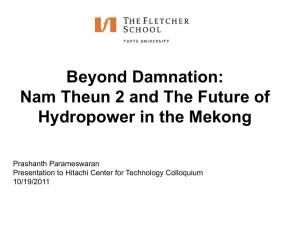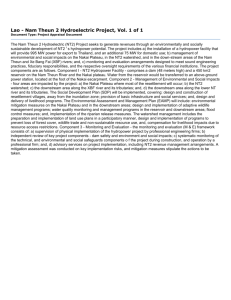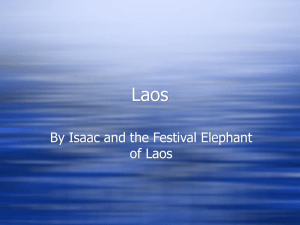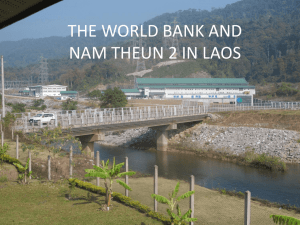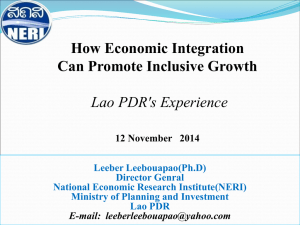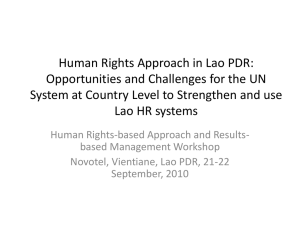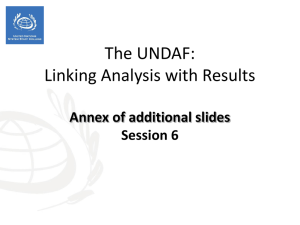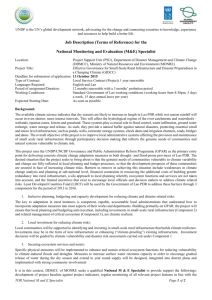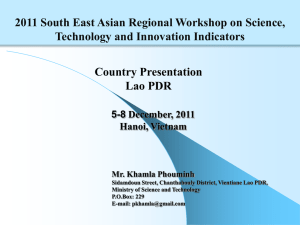GMS Energy Strategy
advertisement
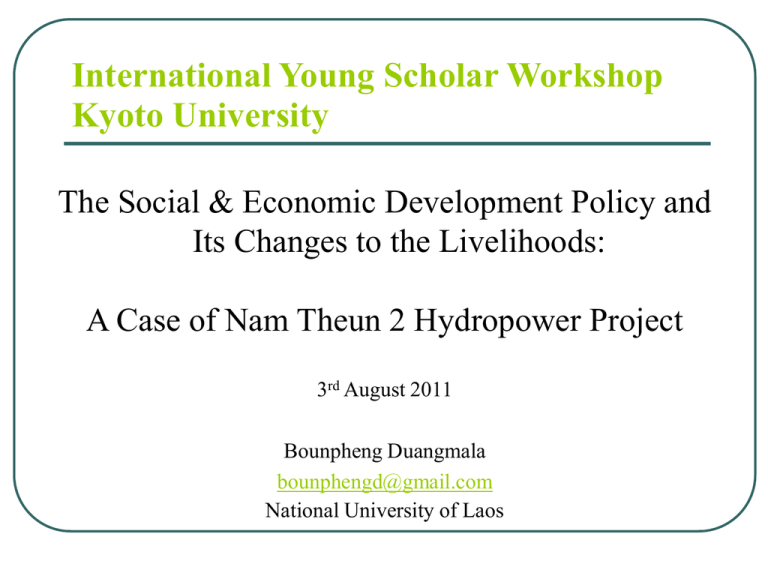
International Young Scholar Workshop Kyoto University The Social & Economic Development Policy and Its Changes to the Livelihoods: A Case of Nam Theun 2 Hydropower Project 3rd August 2011 Bounpheng Duangmala bounphengd@gmail.com National University of Laos Country Overview Lao People’s Democratic Republic (PDR) is a small, landlocked nation of less than six million people at the center of the dynamic Mekong region. The country is facing numerous development challenges but has been undertaking reforms that are helping to embark it on an increasingly sustainable development path. With strong economic performance and structural reforms in trade, private sector development, and public financial management - among others, Lao PDR is fighting poverty, addressing social inequities, and building stronger capacity to manage its rich natural resources. Introduction (cont); The economic transition in Lao PDR From 1986, the New Economic Mechanism (NEM) was introduced with opening up the country, focusing on market oriented economy, competitiveness, less government intervention; promoting all economic agents to participate in the economic development process of the country. A foreign investment code was officially declared in 1988, The Foreign Investment Law 1994, Amended in 2004 and re-amended in 2010. Poverty issues has been seen as a priority task for the government in development agenda. Government policy & its driven-force The World Bank and Asian Development Bank had been also active in pushing Lao PDR to the hydropower project To ensure economic growth, hydropower is an income generating factor and important element in development strategy. In Laos, the exploitable hydropower potential is estimated to be around 18,000 MW in total installed capacity of power plants. To become the ‘battery of South-East Asia’. Government policy & its driven-force (cont) The development strategy from 2000-2020. - To sustain economic growth with security and stability and maintain the GDP growth rate of about 8 % annually. - To achieve the Millennium Development Goals by 2015. - To leave Lao PDR from the least developed countries by 2020 - Ensure sustainability of development between the socio-economic development and natural resource preservation Hydropower and GDP Growth Resource contribution to GDP growth 20 15 7.8 7.7 7.5 4.2 4.1 4.8 4 1.6 2.8 3.7 3 3.5 2003-08 2009 2010 10 7.2 7 5 5.7 0 Electricity and mining 2011-2015 2016-2020 Other sectors Source: World Bank Staff estimates and projections GDP growth (%) Hydropower and GDP Growth by sector (2009) 29.8% 38.5% Agriculthure Industry Services 31.7% Source: www.worldbank.org/lao/trade Electricity demand in ASEAN countries The NT2 Hydroelectric Project Project Cost: $1.45 B (= a half of Laos’ 2005 GDP) Installed Capacity:1,070 MW Reservoir size: 450km2 (= 2/3 of Singapore) Generating revenues to “reduce poverty” by exporting electricity to Thailand * BOOT project (build-own-operate-transfer ) “A model of sustainable development” Vietnam Nam Theun River Nam Theun 2 Dam Thailand Mekong River Xe Bang Fai River Laos Source:International Rivers Power House Source:Mekong Watch Foreign Direct Investment Nam Theun 2 Power Company ($1.45 B) Contract $350 Million 35 25 Italian-Thai: % ( %) 25 EGCO: % ( %) 35 Lao Holding State Enterprise: % ( %) Electricité de France: % ( %) 40 25 15 0 Lao Government (Concession Agreement) EGAT (PPA) Electricité de Lao(PPA) (International Financers) ・World Bank ・ADB ・European Investment Bank ・COFACE (France) ・Private Investors* History of the project International arguments for more than 10 years March - April 2005: World Bank and ADB decided to support the NT2 June 2005: Construction started April 2008: Village resettlement completed /impoundment of the reservoir started March 2010: Full operation started Major Social and Environmental Impacts of the NT2 About 6,200 indigenous peoples on Nakai Plateau have resettled to make way for a reservoir More than 120,000 people downstream are affected (e.g., fisheries, flooded riverbank gardens, deteriorated water quality) Wildlife habitats, including endangered species, were negatively affected. Endangered species in the Nakai Plateau Livelihoods Assets Human Capital Social Capital Natural Capital The Poor Physical Capital Financial Capital Sustainable Livelihoods Framework Hydropower development in Laos after the NT2 70 projects in Laos’ Power Development Plan till 2020 Only 10* out of 70 projects implemented before NT2 The Lao government signed MOUs to implement/research the other projects NT2 as a turning point for Laos’ power sector development Questions about the long-term livelihood restoration in Nakai Plateu Main livelihood has been changed from subsistence rice cultivation to cash crop cultivation. There are no stable markets for cash crops. Upland rice cultivation on 0.66 ha of compensation land not enough space for fallow lands = unsustainable Most resettlement villagers depend on reservoir fisheries It is possible that fish catch declines in several years Grazing land for livestock and forests with rich NTFPs (e.g. Bamboo shoots, mushrooms and etc…) were flooded loss of safety net Conclusion The history of hydropower development in Laos is general and the development of NT 2 in particular. It looked at the major driving forces behind the development of the dam such as economic growth, the state policy to become the ‘Battery of Asia’ and also respond to the energy demand of the neighboring countries, especially Thailand. More work still needs to be done by the project to develop the asset base of the poor especially the human, financial and physical capital in order to create a sustainable livelihood for the resettled communities affected by the NT2 project. Thank you!
